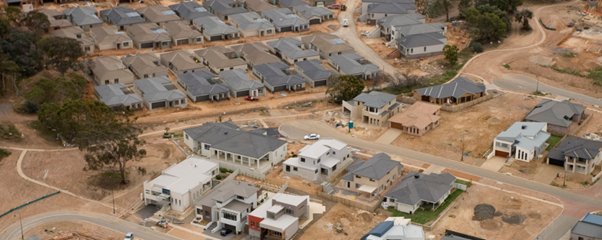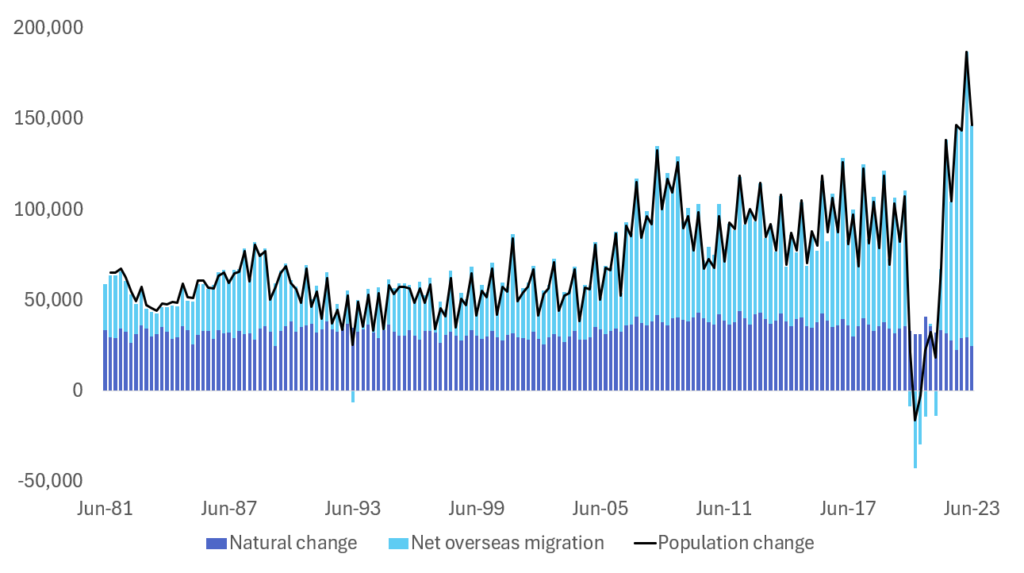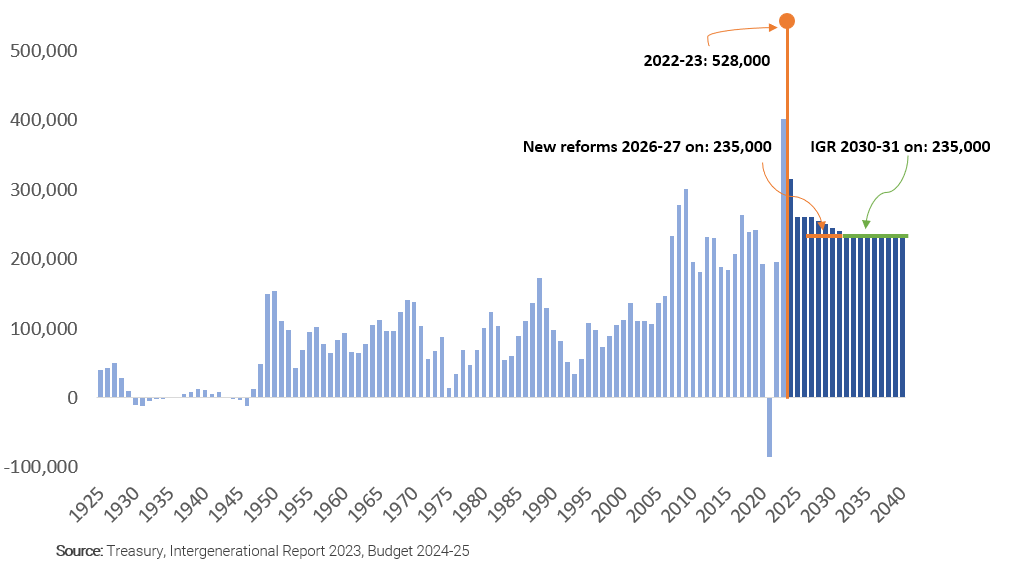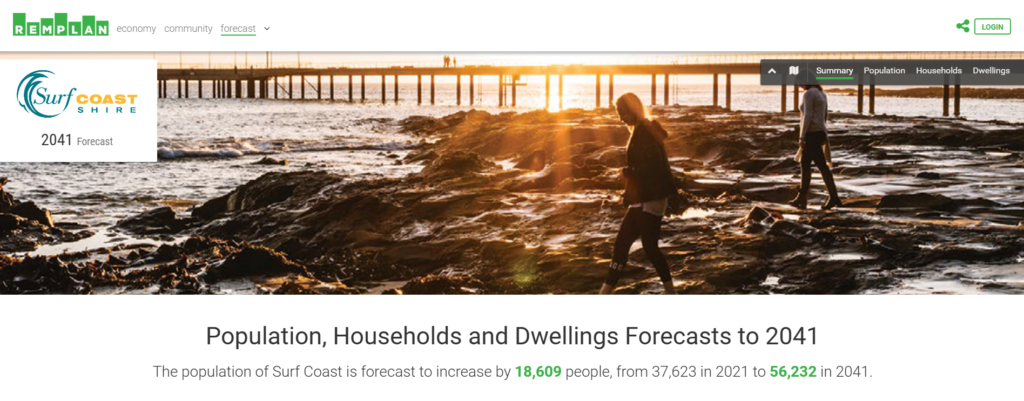01 Jun Federal Government to Halve Overseas Migration from Record Highs Amid Housing Shortage
Authored by Teresa Bullock-Smith – Director of Population Forecasting at REMPLAN – June 2024

Net overseas migration (NOM) has reached its highest level in recorded history
Latest budget has NOM halving from 528,000 to 260,000 in 2024-25
Demand from NOM leaves a shortfall of over 61,000 dwellings
How the new migration policy will affect Australia’s population and housing demand
Migration plays an important role in the economy, including attracting skilled labour, however, this has placed increased pressures on housing demand. In the latest budget, the federal government announced an overhaul of the migration system, slashing the intake of overseas migrants by more than half from 528,000 in 2022-23 to 260,000 by 2024-25. The record NOM highs have provided policy challenges such as housing affordability and housing shortages which have led to the reconsideration of these targets.
The move is aimed at easing the pressures caused by population growth, including housing affordability and infrastructure congestion. But will it solve the current housing crisis, or create new challenges for the economy and society?
Net overseas migration is the main driver of growth in Australia
Net overseas migration (NOM) is the difference between the number of people who arrive in Australia and the number of people who leave, for a period of 12 months or more. It is the main contributor to Australia’s population growth, accounting for about 60% of the increase in the last decade.
Natural change (births less deaths) has been on a steady decline since 2009-10, where it has fallen from 163,000 in the year to June 2010 to 135,000 in the year to June 2020. As the population continues to age this is expected to continue over time.
Australias Population – Components of Change

Net overseas migration is the main driver of growth in Australia, and following the COVID-19 pandemic, has bounced back strongly to new highs, peaking in 2022-23 at 528,000. The new targets signal the Federal Government’s intent to slow the rate of migration and step the number of overseas migrants back down towards a target of 235,000 by 2026-27.
Permanent migration levels have been set at 185,000, with 70% (132,000) being for the skilled stream. The new targets are significantly lower than the projections in the Intergenerational Report (IGR) 2023, which assumed a NOM of 235,000 by 2030-31.
The following chart shows the comparison between the budget and the IGR forecasts for NOM.
Net Overseas Migration – Budget verus Intergenerational Report

How will halving overseas migration affect the housing shortage?
Migration plays an important role in the economy, including attracting skilled labour, boosting consumer demand, and diversifying the population. However, it also places increased pressures on housing demand, especially in the inner areas of capital cities, where most overseas migrants settle. In 2022-23, the net dwelling supply was 148,600 and NOM was 528,400. Based on the national average household size of 2.52 persons, this generates a demand for 209,800 new dwellings, corresponding to a supply shortfall of 61,200 dwellings.
While halving NOM potentially eases future housing pressure by reducing demand, it is not expected to impact or ease the current housing shortage situation. The housing market is also influenced by other factors, such as interest rates, income, supply constraints, and household preferences. Moreover, demand for new dwellings not only comes from population growth (NOM and natural change), but also from market churn derived from household lifecycles, where the demand for dwelling types changes in line with typical lifecycle: moving out of home (lone-person / shared housing); having a family (larger house); to empty nesters (downsizing and lone-person) which effectively shifts demand from one dwelling to two. The household lifecycle also places increased pressures on the housing market.
What are the implications for the economy and society?
While halving overseas migration may seem like a quick fix for the housing shortage, it may also have unintended consequences for the economy and society. Some of the potential impacts are:
- Reduced labour force participation and productivity: Migration contributes to the size and quality of the labour force, especially in the skilled and professional sectors. Reducing migration may lead to skills shortages, lower innovation, and reduced competitiveness in the global market.
- Lower economic growth and fiscal pressure: Migration boosts economic growth by increasing consumer demand, investment, and tax revenue. Reducing migration may lead to lower GDP, lower income per capita, and lower tax revenue. This may also increase the fiscal pressure on the government, as the population ages and the dependency ratio rises.
- Reduced social and cultural diversity: Migration enriches the social and cultural diversity of Australia, bringing new perspectives, ideas, and values.
How does the migration reform address the housing shortage?
- Reducing NOM has the immediate impact of lower population growth across the nation.
- While this potentially eases future housing pressure by reducing demand, this is not expected to impact or ease the current housing shortage situation.
- As always, there will be population winners and losers. Inner areas of capital cities tend to receive the largest share of overseas migrants and will potentially be most directly impacted. All capital cities experienced net overseas migration gain.
- Areas experiencing strong economic growth that have land and labour supply are expected to continue to see population growth.
- Easing NOM does not address the immediate housing crisis to support housing for key workers, first home buyers and those in housing stress – that requires supporting solutions for infrastructure delivery and housing.
Update your population, household formation and dwelling demand forecasts
Local population forecasts are essential tools for policymakers, urban planners, businesses, and communities. They help urban planners design cities and towns that can accommodate future growth. This includes planning for residential areas, commercial zones, public parks, and essential infrastructure like roads, schools and hospitals. Businesses and investors use population forecasts to make evidence-based decisions about where to establish operations, open new stores, or invest in property.
The halving of overseas migration is one example of a policy shift with significant implications for local population forecasts. It is for this very reason that REMPLAN forecasts are reviewed and updated annually.
Example – Population Forecast – Surf Coast LGA

REMPLAN’s team of expert forecasters support local and state governments and private clients across Australia. Contact us for a free consultation regarding population forecasts for your area.
Please call us on 1300 737 443 or contact us online.




No Comments